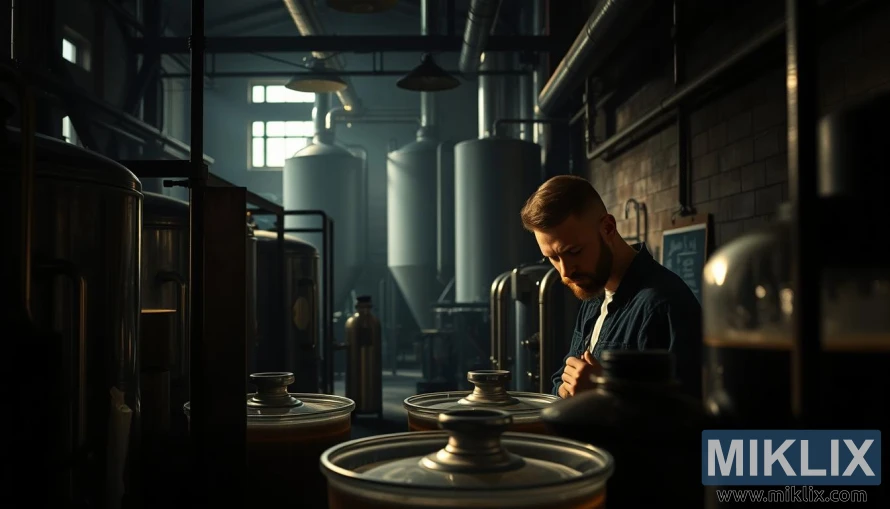Image: Brewer at Work in Dim Brewery
Published: July 26, 2025 at 7:24:58 AM UTC
Last updated: September 27, 2025 at 12:12:10 PM UTC
A brewer examines a hydrometer amid dim lighting, tanks, and grain silos, reflecting the challenges and precision of brewing.
Inside the muted, cavernous interior of the brewery, the light filters down in heavy, deliberate beams, catching on the metallic surfaces of the brewing vessels and casting sharp-edged shadows that stretch across the floor. The atmosphere is dense with steam and the faint tang of malt, the air alive with the scent of sugars breaking down and yeast steadily transforming them into alcohol. In the foreground, a row of half-filled fermentation tanks gleams dully in the low light, their lids reflecting faint ripples of illumination. Each vessel feels almost alive, the subtle gurgle of CO₂ release valves punctuating the stillness with quiet reminders of the ongoing fermentation process. The jumble of pipes, valves, and gauges crisscrossing the scene adds to the sense of complexity, a visual reminder that brewing is as much about navigating challenges as it is about artistry.
Amidst this industrial labyrinth, the solitary figure of a brewer becomes the focal point. He leans forward, his face set in concentration, eyes locked onto the slim column of a hydrometer suspended in its jar of wort. His furrowed brow and tense posture betray the weight of the moment—a calculation of gravity, temperature, and time, distilled into a reading that will determine whether the batch is on track or veering toward trouble. The dim light accentuates the intensity of his expression, the seriousness of someone who understands that every decision, every minor adjustment, could mean the difference between success and failure. There is a quiet gravity to his stance, a sense that he is engaged in more than routine testing—this is problem-solving at its most precise, a brewer wrestling with the stubborn unpredictability of living yeast and chemical reactions.
Beyond him, the middle ground reveals the brewery’s architecture: towering silos loom like sentinels in the hazy gloom, their bulk a testament to the scale of raw ingredients required for production. A faint chalkboard leans against the wall, its surface smudged with hastily written notes—ratios, temperatures, perhaps reminders of experimental adjustments. These details, though barely visible, underscore the intellectual side of brewing, where technical knowledge, quick calculations, and constant observation converge with practical labor. Every mark on that board represents both uncertainty and potential, a roadmap of challenges waiting to be solved.
The composition conveys a tension between shadow and light, between control and unpredictability. The dim lighting, broken by stark industrial fixtures, adds weight to the scene, suggesting a space where mistakes are costly but solutions are within reach for those patient and meticulous enough to find them. Yet within this heaviness, there is also resilience. The brewer’s focus, the gleaming vessels, and the quiet rhythm of fermentation speak not only of difficulty but also of determination and progress.
Ultimately, the scene encapsulates the essence of brewing as both craft and science. It acknowledges the obstacles—fluctuating fermentation rates, temperature shifts, unexpected variances in raw materials—but frames them within an atmosphere of resolve. Brewing here is not romanticized; it is shown for what it truly is: an intricate, problem-laden process demanding knowledge, skill, and perseverance. And yet, in the way the brewer hunches over his hydrometer, there is also a subtle suggestion of triumph—the belief that with enough care and attention, the solution will be found, and the batch will succeed.
The image is related to: Hops in Beer Brewing: Galena

